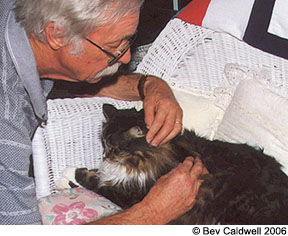“The owner is the veterinarians eyes and hands away from the office,” explains Jim Richards, DVM, director of Cornells Feline Health Center. For this reason, it is important to be familiar with the steps involved in doing an at-home mini-physical examination on your cat. This should supplement your cats twice yearly trips to the veterinarian.

288
Performing an at-home physical examination is much easier than you might think; in fact, Dr. Richards points out, the examination should be a normal extension of the regular attention you give your cat. Here are some easy-to-follow ground rules:
u Dont restrain your cat when you do the examination. She should be comfortably nestled in your lap or, if shes not a lap cat, you can place her on a raised surface.
u No fighting. If she starts to struggle, take a break.
u Never attempt an examination after a play session. Do it when your cat is quiet and relaxed.
u Its not necessary to do the whole examination at once. You can do a little at a time over the course of a week.
Getting Started
Next, look at your cats rear end. Lift her tail and check for tapeworm infection, which will appear as rice-like segments stuck in the hair. Also, if your cat has long hair, make sure she doesnt have feces matted in the hair on her bottom.
Inspect her toes to make sure she doesnt have any ingrown toenails. This is a special concern with older cats, and may be an issue with polydactyl cats (cats with extra toes).
Look in her ears: They should be light pink (unless theyre pigmented) and there should not be any odor or discharge. To look down into the ear, you can gently pull the top of the ear upward.
Bright Eyes
Open Wide!
In a short amount of time, you will have, as Dr. Richards explains, made sure that “everything is going as it should.” Its important to watch for slight changes in behavior, as well as any physiological problems. Subtle signs of illness include lethargy, change in appetite and water consumption (eating or drinking more or less than usual), changes in grooming behavior (oily coat or overgrooming are red flags), weight loss and any changes in litter box behavior.
If you have any concerns, a visit to the veterinarian is in order.


